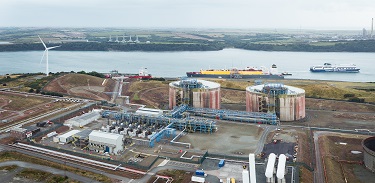 There are only three liquid natural gas import terminals in the UK. Two of them are here in Pembrokeshire. South Hook LNG Terminal sits on the site of the former Esso refinery outside Milford Haven and Dragon LNG is in Waterston, near Neyland, where the Gulf refinery once sat.
There are only three liquid natural gas import terminals in the UK. Two of them are here in Pembrokeshire. South Hook LNG Terminal sits on the site of the former Esso refinery outside Milford Haven and Dragon LNG is in Waterston, near Neyland, where the Gulf refinery once sat.
To understand why the Milford Haven Waterway became one of the most important players in the UK’s gas strategy you need to turn the clock back to 2004. In that year, the nation started using more gas than its own depleted North Sea fields could supply. Anticipating the risk of being over reliant on European gas supplied by pipeline, the government called for new terminals to be constructed to import gas via shipments from further afield. Both terminals were commissioned in 2009.
The only practical way to transport large volumes of gas by sea is by first turning it into a liquid. This is done by chilling it down to just below -160°C.
“When natural gas is liquefied, it takes up a lot less space,” explains Karen Wood, Stakeholder and Communications Manager at Dragon LNG. “In its liquid state, it has 600 times less volume. Dragon can accommodate LNG ships that can carry up to 217,000m3 of LNG; that adds up to a lot of gas that comes to our jetty in each shipment.”
Once on land, the LNG is stored in two giant tanks. Lead Instrument Technician, Wes Tucker, has worked at Dragon LNG from the start and has a clear memory of standing inside one of the new tanks. “I remember standing inside in the pitch black. The light from my torch did not even reach the other side!” The tanks’ concrete walls are insulated with perlite and lined with a nickel alloy steel capable of withstanding the cold temperature.
“The LNG is kept typically at 100 to 200 mb above atmospheric pressure and any gas that boils off gets re-liquefied in a giant refrigeration process and pumped back in,” explains Wes. Dragon LNG used to burn this so-called boil off gas to generate electricity and heat for their own needs. However, as part of plans to reduce the business’s carbon footprint, they are hopeful that renewables (solar and wind) will soon provide up to half of the site’s power.
“Our company group is in the middle of a planned £30m investment to decarbonise our energy usage,” says Karen. “We are installing 18,500 solar panels and that work should be completed by the end of this year. We are also in mid-consultation with a view to installing three wind turbines next to the existing array on Wear Point. Together, the renewable energy sources could meet nearly half of our energy needs.”
You might be forgiven for thinking our two LNG terminals, South Hook and Dragon LNG, have the same job to do. After all, the same sort of ships carrying identical product come in to berth at their respective jetties. But each terminal plays a slightly different role in the UK’s energy mix.
It’s a very rough analogy, but if you think of the Milford Haven Waterway as a ‘kitchen’ feeding energy to the UK, Valero Pembroke Refinery could be thought of as the stove where all the clever cooking is done. The tank farms on the north bank are the larders. South Hook LNG Terminal is the fridge, on hand for fresh energy requests throughout the day. With Dragon LNG being both fridge and chest freezer for when you have unexpected numbers for dinner, you dig into the deep freeze. The ‘2019 Beast from the East’ was an example when Dragon LNG played a significant role in continuing to provide energy for the UK.
Where we source our energy is one of the big issues of our time. While Dragon LNG helps give the UK the diversity of supply that we need, it has no influence over supply sources, prices or the amount that it sends into the network. It is an energy handler.
“Dragon LNG doesn’t own the gas,” explains Karen. “We are here to receive and store LNG for our customers and the terminal sends out to the UK’s National Grid when required. Our job is to operate a safe and reliable service.”


